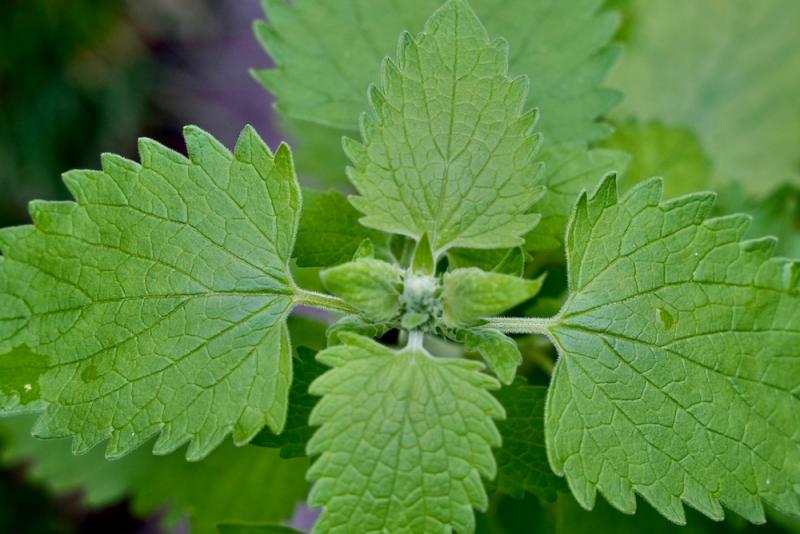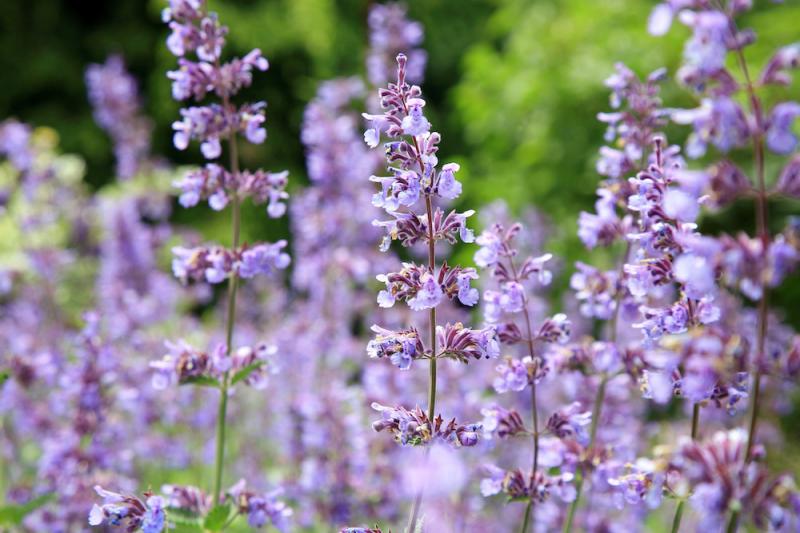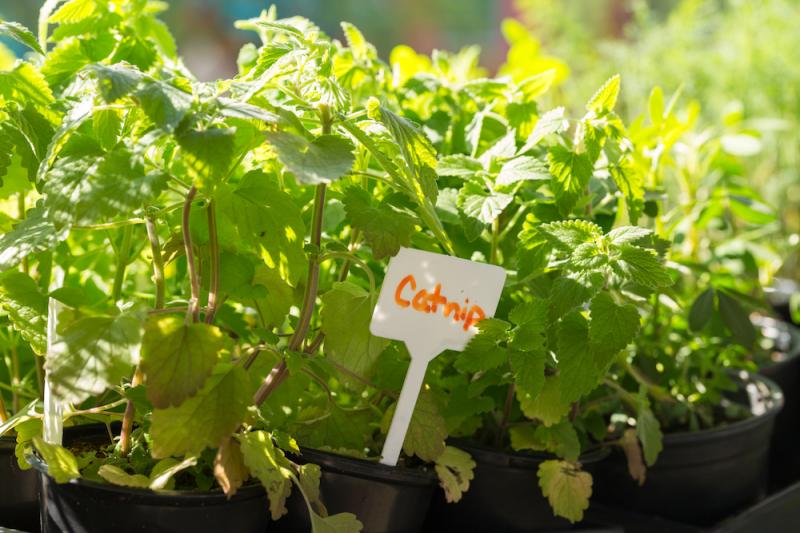
In addition to being a good remedy for kids and adults, catnip has an amusing and harmless effect on many cats. This member of the mint family is intoxicating to about 50%-70% of all cats. It even acts as a bit of an aphrodisiac for them. Cats don’t actually eat it, but they will bruise and tear the plant to release the essential oil and inhale its vapors.
I remember observing this effect while I was living in an apartment in Spokane in the late 1970s. My wife was explaining the effects that catnip has on cats to the neighbor who had two Siamese cats when some got spilled on the carpet. The male Siamese got down and practically wallowed in it. The female, acted more prim and proper, stood over it looking around as if to see if anyone was watching, quickly rubbed her head on the carpet where the catnip was and then looked up almost like she was embarrassed. It was funny.
Years later I planted catnip in my backyard in Leeds, Utah and cats in the neighborhood kept destroying it. I had to cover it with a jar until it got big enough to withstand the damage from the cats. By the way, if you have a cat that likes catnip, don’t be concerned; it’s not harmful to them.
Medicinal Effects of Catnip
 During the 1960s and 1970s catnip was a popular smoking herb for its mildly euphoric and relaxing effects. But, you shouldn't smoke it. I don’t recommend smoking herbs in general and there are some side effects to smoking catnip. Instead it is a great ingredient in formulas and as a tea. It has a mild sedative effect and can ease anxiety and indigestion caused by stress. It isn't a very strong sedative and tends to work better as part of a formula.
During the 1960s and 1970s catnip was a popular smoking herb for its mildly euphoric and relaxing effects. But, you shouldn't smoke it. I don’t recommend smoking herbs in general and there are some side effects to smoking catnip. Instead it is a great ingredient in formulas and as a tea. It has a mild sedative effect and can ease anxiety and indigestion caused by stress. It isn't a very strong sedative and tends to work better as part of a formula.
Catnip’s major medicinal use is to ease digestive upset, which is what I’ve used it for the most. Back in the 1980s when I was getting started as an herbalist, some of my teachers called it Nature’s Alka-Seltzer. Catnip helps relax stomach cramps, acts as a carminative to expel intestinal gas, and calms the nervousness that contributes to digestive upset.
Catnip Formulas for Indigestion
 Combined with fennel, catnip is a traditional remedy for colic in infants and children. Years ago I would make catnip tea and sweeten it with a little corn syrup (honey is not recommended for infants) and give it in a baby bottle to ease a colicky infant. It was hard to get the child to drink much, so I started making the formula as a sealed simmer glycerite. That way I could give the child about 10 drops by mouth and then have them nurse or drink from a bottle.
Combined with fennel, catnip is a traditional remedy for colic in infants and children. Years ago I would make catnip tea and sweeten it with a little corn syrup (honey is not recommended for infants) and give it in a baby bottle to ease a colicky infant. It was hard to get the child to drink much, so I started making the formula as a sealed simmer glycerite. That way I could give the child about 10 drops by mouth and then have them nurse or drink from a bottle.
Later I made improvements to the traditional remedy. The first I dubbed Super Catnip and Fennel, which involves combining 2 parts catnip, 2 parts fennel seed, 1 part meadowsweet. Then, when I had a particularly troubling case of infant colic I created a stronger formula. This one contained 2 parts catnip, 2 parts fennel seed, 1 part meadowsweet, 1 part peppermint, and ¼ part lobelia. I used a sealed simmer glycerite to make both of these formulas and used a dose of 5-10 drops for an infant, 10-30 drops for a toddler, and 30-60 drops for an adult. The stronger formula works best for easing severe colic and intestinal cramping in adults.
Other Uses for Catnip
 Catnip is also a good remedy for colds and flu in children. It has a mild decongestant action and also acts as a sudorific to help reduce fever. For fever, I’ve used catnip tea in an enema with good success. Catnip has also been used both internally and in an enema for skin eruptive diseases such as measles and chickenpox.
Catnip is also a good remedy for colds and flu in children. It has a mild decongestant action and also acts as a sudorific to help reduce fever. For fever, I’ve used catnip tea in an enema with good success. Catnip has also been used both internally and in an enema for skin eruptive diseases such as measles and chickenpox.
Catnip is also an important ingredient in my Children’s Composition Formula which is good for colds, flu, and other acute viral infections especially when fever is present. The recipe can be found in Modern Herbal Dispensatory.
Catnip can be combined with chamomile to promote sleep in children and with stronger nervines like hops, valerian, skullcap, and passion flower for insomnia in adults. It can also ease headaches associated with indigestion.
Using Catnip
For reducing stress and aiding digestion adults can take two capsules with each meal. Two to four capsules can be taken at bedtime. It also works well as a tea. To make the tea steep 1-2 tsp of the dried herb in 8 oz. of water for 10-20 minutes. You can also make the tea using a tincture made from the fresh plant. If you can make a fresh plant glycerite using the sealed simmer method that’s the best way I've found to use catnip. This method is especially good when using it with children.
Steven's Articles
October
-

-
Understanding Caffeine & Cellular Adaptation
Preserving the power of caffeine's buzz and the…
September
-

-
Horseradish
A pungent spice for aiding protein metabolism…
-

-
Banaba or Crepe Myrtle
A beautiful tree from Southeast Asia whose leaves…
August
-

-
Monkeyflowers
Flower essences to help see ourselves more clearly…
-

-
Mariposa Lilies
Strengthening the bond between mother and child…
-

-
The Noble Bay Leaf
A common kitchen herb for aiding digestion and…
-

-
Epimedium: Horny Goat Weed
A circulatory stimulant and kidney yang tonic…
July
-

-
The Medicinal and Nutritional Benefits of Apricots
A nutritious fruit and valuable medicinal seed for coughs
-

-
Dogwoods
Asian dogwood is used to stop excessive discharge,…
June
-

-
Neem: The Village Pharmacy
A popular Ayurvedic remedy for dental and immune…
-

-
Spilanthes: The Toothache Plant
A traditional remedy for teeth and gums, as well…
-

-
Forsythia
An anti-inflammatory, fever-reducing, and infection fighting herb
May
-

-
Buckwheat (Kashi)
A delicious, high protein, gluten-free, gut-healthy food
-

-
Leaky Gut Syndrome
Plugging the leaks on the underlying cause of…
-

-
Storksbill
An edible, medicinal, weedy herb, helpful for…

